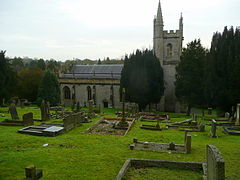Piltonis a village andcivil parishinSomerset,England, situated on theA361 roadin theMendip district,3 miles (5 km) south-west ofShepton Malletand 6 miles (10 km) east ofGlastonbury.The village has apopulationof 998.[1]The parish includes the hamlets ofWest Compton,East Compton,Westholme,Beardly BatchandCannards Grave.
| Pilton | |
|---|---|
 | |
Location withinSomerset | |
| Population | 998 (2011)[1] |
| OS grid reference | ST595405 |
| Unitary authority | |
| Ceremonial county | |
| Region | |
| Country | England |
| Sovereign state | United Kingdom |
| Post town | SHEPTON MALLET |
| Postcode district | BA4 |
| Dialling code | 01749 |
| Police | Avon and Somerset |
| Fire | Devon and Somerset |
| Ambulance | South Western |
| UK Parliament | |
History
editPilton is now almost 20 miles (30 km) from the sea but sits on the edge of theSomerset Levels,an area which has now been drained but was once a shallow tidal lake. According to legend in the 1st century, being a landing place then known as Pooltown, it is whereJoseph of Arimathealanded in Britain.
The parish of Pilton was part of theWhitstoneHundred.[2]
Cannard's Graveis located on the southern edge ofShepton Mallet.Local legend (of which there are several versions) says that, in the 17th century, the publican of the local inn, Giles Cannard (possibly also known as Tom the Taverner), engaged in criminal activity such as robbing, oraiding and abettingtherobberyof, his guests, theft,smugglingand possiblyforgery.His activities having been discovered, he either committed suicide or was convicted andhangedfrom thegibbetat the adjacent crossroads and buried nearby.[3][4]Other explanations of the name include a tale that Kenred a pagan and uncle ofKing Inewho converted to Christianity was buried there. Perhaps the most likely story is that a thief convicted of sheep stealing was tried and hanged at the site.[5]
Governance
editTheparish councilhas responsibility for local issues, including setting an annual precept (local rate) to cover the council’s operating costs and producing annual accounts for public scrutiny. The parish council evaluates local planning applications and works with the local police, district council officers, andneighbourhood watchgroups on matters of crime, security, and traffic. The parish council's role also includes initiating projects for the maintenance and repair of parish facilities, as well as consulting with the district council on the maintenance, repair, and improvement of highways, drainage, footpaths, public transport, and street cleaning. Conservation matters (including trees and listed buildings) and environmental issues are also the responsibility of the council.
The village falls within theNon-metropolitan districtofMendip,which was formed on 1 April 1974 under theLocal Government Act 1972,having previously been part ofShepton Mallet Rural District,[6]which is responsible forlocal planningandbuilding control,local roads,council housing,environmental health,marketsand fairs,refuse collectionandrecycling,cemeteriesandcrematoria,leisure services, parks, andtourism.
Somerset County Councilis responsible for running the largest and most expensive local services such aseducation,social services,libraries,main roads,public transport,policingandfire services,trading standards,waste disposaland strategic planning.
It is also part of theWells and Mendip Hillscounty constituencyrepresented in theHouse of Commonsof theParliament of the United Kingdom.It elects oneMember of Parliament (MP)by thefirst past the postsystem of election.
Church
editThe presentMedievalvillage church, dedicated toSt John the Baptist,may stand on the site of an earlierwattle and daubchurch built by the early missionaries. It has been designated byEnglish Heritageas a Grade Ilisted building.[7]
Listed buildings
editThe village has a Grade II* listedmanor house[8]and a Grade I listedtithe barn,which belonged toGlastonbury Abbey.[9]
Culture
editPilton is famous as the location of theGlastonbury Festival,which is run by Pilton farmerMichael Eavisand his daughterEmily Eavis.All villagers get a free ticket.
References
edit- ^ab"Pilton Parish".Neighbourhood Statistics.Office for National Statistics. Archived fromthe originalon 2 January 2014.Retrieved1 January2014.
- ^"Somerset Hundreds".GENUKI.Retrieved22 October2011.
- ^"The Story of Cannards Grave (mid-17th Century)".Shepton Mallet Town Council. Archived fromthe originalon 21 July 2011.Retrieved18 December2010.
- ^Grantham, Paul (17 February 2004)."Cannard's Grave".Unconsecrated burials of Britain.Retrieved14 September2012.
- ^Warren, Derrick (2005).Curious Somerset.Stroud: Sutton Publishing. p. 32.ISBN978-0-7509-4057-3.
- ^"Shepton Mallet RD".A vision of Britain Through Time.University of Portsmouth.Retrieved4 January2014.
- ^Historic England."Church of St John the Baptist (1058818)".National Heritage List for England.Retrieved28 September2008.
- ^Historic England."The Manor House and attached wall to rear (1175218)".National Heritage List for England.Retrieved28 September2008.
- ^Historic England."Former Tithe Barn in farmyard at Cumhill Farm (1058842)".National Heritage List for England.Retrieved28 September2008.
